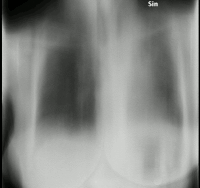
Photo from wikipedia
The answer is Aspergillus fumigatus periorbital mass. Upon review of the histopathology, Aspergillus and Fusarium were considered the most likely possible diagnoses. Due to variable susceptibility of Fusarium to azoles,… Click to show full abstract
The answer is Aspergillus fumigatus periorbital mass. Upon review of the histopathology, Aspergillus and Fusarium were considered the most likely possible diagnoses. Due to variable susceptibility of Fusarium to azoles, empirical liposomal amphotericin (i.v., 5 mg/kg daily) was started. Formalin-fixed tissue was sent for broad-range fungal PCR (1). MRI 6 days after the start of amphotericin showed minimal change, and symptoms were similar. Further surgical intervention to provide any modicum of source control was not deemed feasible without enucleation of the left eye. Aspergillus fumigatus was detected with 28S, internal transcribed spacer, and nested internal transcribed spacer primer sets. Treatment was transitioned to voriconazole. Periorbital swelling began to improve, and the patient was discharged 13 days after surgery. At that time, his vision, ptosis (inability to open his eye at all), and proptosis were unchanged. In follow-up, voriconazole levels were within therapeutic range and there was no sign of liver toxicity, although the patient did have intermittent vivid dreams and a salty taste in his mouth. He eventually developed some distal lower extremity neuropathy. By 2 weeks after discharge, his vision had started to improve; he was able to see figures in addition to light and was able to open his eye slightly. MRI at that time showed no change in the mass and an interval subacute enhancing infarct in the right lateral cerebellar hemisphere. He was seen in the neurology clinic follow-up for secondary prevention. He continued voriconazole with frequent follow-up visits and occasional imaging. Voriconazole was stopped after 54 weeks of therapy. Approximately 18 months after diagnosis and 6 months after stopping therapy, he had a slight left eye central defect and rare sharp headaches, but proptosis and ptosis had completely resolved. Visual acuity was noted to have improved to 20/40 in his left eye. Repeat MRI at that time (6 months after stopping treatment) showed complete resolution of the mass. No enucleation surgery was required. In this case, Aspergillus may have been introduced into the orbital apex during or after the ozone treatment of the patient’s sinuses. The exact time when Aspergillus might have been introduced is not certain. His symptoms began after the treatment, leading to empirical courses of corticosteroids at doses that were escalated as his symptoms worsened, likely leading to further progression of disease, which eventually became quite rapid in pace with severe sequelae. This case is a poignant example of the potential dangers of empirical corticosteroid therapy and the importance of considering infectious causes in similar cases with subacute progression. In this case, it was fortunate that the surgical pathologist noted fungal elements on biopsy and that broad-range fungal PCR was able to identify Aspergillus fumigatus. However, such cases could easily be missed, with dire consequences, should infection not be suspected.
Journal Title: Journal of Clinical Microbiology
Year Published: 2022
Link to full text (if available)
Share on Social Media: Sign Up to like & get
recommendations!